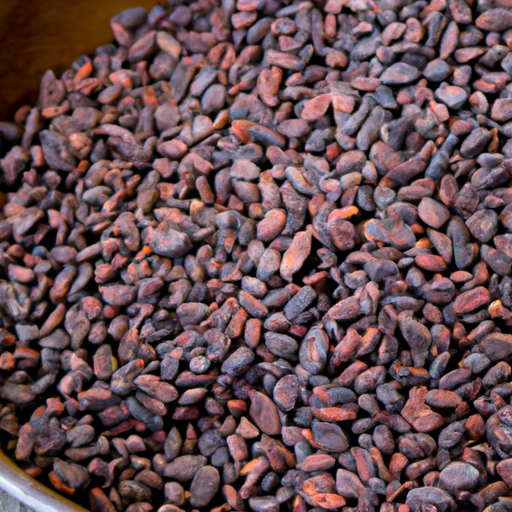Did you know that properly tempering raw cacao butter can take your chocolate creations to the next level? It’s true! With the correct techniques, you can achieve a smooth, glossy finish and that satisfying snap when you break into a chocolate bar.
In this article, I will guide you through the process of tempering raw cacao butter, step by step.
First, we will explore the properties of raw cacao butter and why tempering is essential for achieving the desired texture and appearance.
Then, I will provide you with detailed instructions on preparing your workspace and equipment, melting the raw cacao butter, and seeding it with unmelted butter.
We will cover stirring and cooling techniques, as well as how to test and verify the temper.
Finally, I will share tips on pouring and setting the tempered cacao butter, storing it properly, and troubleshooting common issues that may arise.
So, if you’re ready to take your chocolate creations to the next level, let’s dive into the fascinating world of tempering raw cacao butter!
Key Takeaways
- Tempered cacao butter enhances flavor and texture
- Can be used in baked goods, chocolates, smoothies, and skincare products
- Improves skin elasticity and provides a natural glow
- Troubleshooting common tempering issues is essential
Understanding the Properties of Raw Cacao Butter
Now, let’s dive into the fascinating world of raw cacao butter and discover its unique properties that make it such a versatile ingredient in your culinary adventures.
Raw cacao butter offers numerous benefits when used in skincare products. Its high content of antioxidants, vitamins, and fatty acids nourish the skin, promoting a healthy and youthful appearance. It also acts as a natural moisturizer, deeply hydrating and softening the skin.
It’s important to differentiate between raw cacao butter and regular cocoa butter. Raw cacao butter is extracted from cold-pressed cacao beans, while regular cocoa butter is derived from roasted cocoa beans. This key difference in processing methods gives raw cacao butter a more intense aroma and a richer nutritional profile.
Now that we understand the properties of raw cacao butter, let’s move on to preparing our workspace and equipment for tempering.
Preparing Your Workspace and Equipment
First, make sure you’ve gathered all your tools and set up your workspace, just like a skilled artist arranging their brushes before starting a masterpiece. Here are four key steps to organize your workspace and maintain your equipment for tempering raw cacao butter:
-
Clear and clean your workspace: Remove any clutter and wipe down the surface to create a clean and organized area to work in.
-
Gather your equipment: Ensure you have all the necessary tools, such as a double boiler, thermometer, spatula, and molds, within easy reach to streamline the tempering process.
-
Check equipment condition: Inspect your equipment for any damages or wear and tear. Replace any faulty or worn-out parts to ensure optimal performance.
-
Maintain cleanliness: Regularly clean and dry your equipment thoroughly after each use to prevent any buildup or contamination.
With your workspace organized and equipment maintained, you are now ready to move on to the next step of melting the raw cacao butter.
Melting the Raw Cacao Butter
To create a delectable treat, start by melting your rich and creamy cacao butter. Melting raw cacao butter is a crucial step in the tempering process. There are several tempering techniques you can use to achieve the desired results. One common method involves using a double boiler, where you place the cacao butter in a heatproof bowl set over a pot of simmering water. This gentle heat ensures that the butter melts slowly and evenly. Alternatively, you can use a microwave to melt the cacao butter in short bursts, stirring in between to prevent overheating. Whichever method you choose, it’s important to melt the cacao butter to its ideal temperature, usually around 45-50°C (113-122°F), before moving on to the next step of seeding the melted butter with unmelted butter.
Transitioning into the subsequent section, seeding the melted butter with unmelted butter helps to cool it down and encourages the formation of stable cocoa butter crystals.
Seeding the Melted Butter with Unmelted Butter
One way to enhance the cooling process and encourage stable cocoa butter crystal formation is by adding chunks of solid butter to the melted mixture. This technique, known as the seeding technique, helps to promote the growth of desirable cocoa butter crystals, resulting in a smooth and glossy final product.
Here are five reasons why seeding the melted butter with unmelted butter is beneficial:
- It provides a source of existing cocoa butter crystals for the melted mixture to grow upon.
- The solid butter helps to cool down the mixture to the proper temperature for crystal formation.
- The addition of unmelted butter aids in creating a uniform texture throughout the final product.
- Seeding can help prevent the formation of unwanted cocoa butter crystals, such as beta crystals, which can result in a gritty texture.
- This technique helps to ensure a consistent and high-quality end result.
With the melted butter seeded with unmelted butter, the next step is to stir and cool the mixture, which will further facilitate the formation of stable cocoa butter crystals.
Stirring and Cooling the Mixture
Now, grab your spoon and gently swirl the mixture in circular motions, allowing the melted butter and unmelted butter to blend together beautifully. During this cooling process, it’s crucial to use the right stirring techniques to achieve the desired temper in your cacao butter. By stirring continuously, you promote even cooling and distribution of the unmelted butter throughout the mixture. This ensures a consistent and smooth texture in your final product. To help visualize the importance of stirring, consider the following table:
| Stirring Technique | Result |
|---|---|
| Gentle and Slow | Creamy texture |
| Vigorous and Fast | Grainy and uneven texture |
| Intermittent | Inconsistent temper |
As you stir and cool the mixture, keep an eye out for any changes in texture or appearance. Once the desired temper is achieved, it’s time to move on to the next section and test the temper without any further delay.
Testing the Temper
Once you’ve completed the stirring and cooling process, it’s time for you to test whether the desired temper has been achieved.
There are a few different testing methods you can use to ensure that your cacao butter is properly tempered.
One common method is the ‘seed test,’ where you dip a clean spoon into the melted cacao butter and let it sit at room temperature for a few minutes. If the butter sets and hardens evenly, it means that you’ve achieved the right temper.
Another method is the ‘snap test,’ where you break a small piece of the cooled cacao butter and listen for a clean, crisp snap.
These testing methods are considered best practices in determining the temper of your cacao butter.
With the temper confirmed, you can then move on to pouring and setting the tempered cacao butter, ensuring a smooth and glossy finish.
Pouring and Setting the Tempered Cacao Butter
After testing the temper of the cacao butter, it’s time to move on to the next step: pouring and setting the tempered cacao butter.
This is where pouring techniques come into play to achieve a smooth texture. When pouring the tempered cacao butter, it’s important to do it slowly and steadily, ensuring an even distribution. This helps prevent any air bubbles from forming and maintains the smoothness of the final product.
As the cacao butter sets, it will harden into a glossy finish with a snap when broken. This indicates that the temper has been successful. Once the tempered cacao butter has set, it can be stored and used for various culinary creations.
Now, let’s delve into the next section, where we will explore the best practices for storing and using tempered cacao butter.
Storing and Using Tempered Cacao Butter
To effectively store and utilize your perfectly tempered cacao butter, you’ll need to follow these simple guidelines.
When using tempered cacao butter in recipes, it’s important to remember that it can enhance the flavor and texture of your creations. Incorporating tempered cacao butter into baked goods, chocolates, or even smoothies can add a rich and velvety taste.
Additionally, tempered cacao butter can also be used in skincare products due to its moisturizing and nourishing properties. It can help improve the elasticity of the skin and provide a natural glow.
To ensure the longevity of your tempered cacao butter, store it in an airtight container in a cool, dry place away from direct sunlight.
Now, let’s delve into troubleshooting common tempering issues and how to overcome them.
Troubleshooting Common Tempering Issues
If you find yourself grappling with tempering dilemmas, fear not, as we dive into the troubleshooting of common issues that can arise when working with this delectable ingredient.
When it comes to troubleshooting tempering techniques for cacao butter, there are a few common problems that can occur. One issue is when the chocolate doesn’t have a glossy finish after tempering. This can happen if the chocolate isn’t tempered at the correct temperature or if it isn’t agitated enough during the tempering process.
To achieve a glossy finish, it’s important to ensure that the cacao butter is heated and cooled to the right temperatures and that it is constantly stirred or agitated during the tempering process.
By following these steps and troubleshooting any issues that arise, you can successfully achieve a beautiful glossy finish on your tempered cacao butter creations.
Frequently Asked Questions
What is the best temperature to melt raw cacao butter?
The best temperature to melt raw cacao butter is around 104 to 113 degrees Fahrenheit. This ensures the butter melts evenly and retains its nutritional benefits. Proper temperature control is crucial for achieving the desired results when tempering cacao butter.
Can I use a microwave to melt cacao butter?
Oh, the wonders of modern technology! While some may argue that using a microwave to melt cacao butter is as safe as juggling chainsaws, fear not! There are alternative melting methods that won’t leave you with a kitchen disaster.
How long does it take for the tempered cacao butter to set?
Tempered cacao butter sets faster than regular cacao butter due to the controlled cooling process. To speed up the setting process, you can place it in the refrigerator or freezer. Cooling time can vary but usually takes around 15-30 minutes.
How does tempered cacao butter differ from regular melted cacao butter?
Tempered cacao butter differs from regular melted cacao butter in its texture and stability. The tempering process involves controlled heating and cooling, resulting in a smoother, glossy finish. This enhances the flavor, appearance, and shelf life of chocolate products.
Can I reuse tempered cacao butter for future recipes?
Yes, you can reuse tempered cacao butter for future recipes, just like a trusty Swiss Army knife. It can be used in various ways, such as making chocolates, moisturizing your skin, or even as a lip balm.
Can I Use Tempered Cacao Butter to Sweeten Raw Cacao Nibs?
Yes, you can use tempered cacao butter to sweeten raw cacao nibs for a delicious sweet raw cacao nibs recipe. The tempered cacao butter will add a smooth texture and rich flavor, making it the perfect sweetener for raw cacao nibs. Try it in your next dessert creation!
Conclusion
In conclusion, tempering raw cacao butter is a precise process that requires patience and attention to detail. By understanding the properties of cacao butter and following the steps outlined, you can achieve a smooth and shiny finish, perfect for creating delicious chocolate treats.
Remember, practice makes perfect, so don’t be discouraged if you encounter some troubleshooting along the way. With a little perseverance, you’ll soon be able to ‘hit the sweet spot’ and create beautifully tempered cacao butter every time.
Happy tempering!










